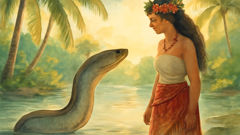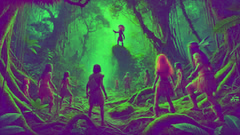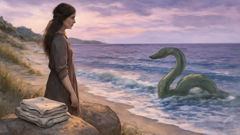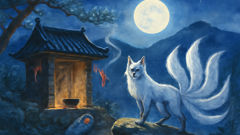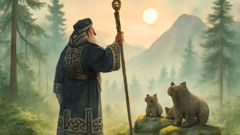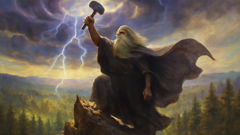Introduction
In the heart of the Pacific, where lush rainforests spill into turquoise lagoons and the wind carries the song of waves through coconut palms, the islands of Samoa cradle ancient stories whispered from one generation to the next. Among these tales, none is more cherished than the legend of Sina and the Eel—a story that dances on the lips of elders beneath starlit skies and flickers in the imagination of every child who gazes up at a coconut tree. For in Samoa, every coconut is more than a fruit; it’s a living symbol, its shell carved with the memory of love, longing, and transformation. This legend unravels in a world where the boundaries between humans and spirits are thin as morning mist, and where even the smallest encounter can ripple into something wondrous and eternal. From the gentle sway of palm leaves to the quiet shimmer of water in hidden pools, the land remembers, and so does its people. Sina, a maiden whose beauty was sung of across islands, whose laughter was bright as dawn, became the center of a story that would entwine her fate with that of a mysterious eel—an encounter that would bring forth the first coconut tree and shape the landscape and hearts of Samoa forever. Let the waves carry you back to a time before time, to a place where legends are as real as the trees that line the shore and as lasting as the love that blooms even in parting.
Sina’s Island: Beauty, Longing, and the Whispering Waters
Long before the bustling canoes and modern villages, Samoa was a tapestry of untouched forests, secret pools, and hidden paths woven through flowers whose scents drifted on the breeze. In one such village, nestled beside a lagoon so clear that the sky itself seemed to swim within it, lived Sina—a maiden as radiant as the dawn. Her eyes sparkled with the mischief of waterfalls and her hair tumbled like a river over her shoulders. The elders told stories of her kindness, how she gathered flowers for her mother and laughter for the children. But Sina’s heart was filled with a quiet longing, a sense that something—someone—was missing from her life.
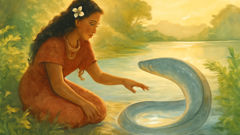
Sina’s days were shaped by the rhythm of the land. She woke each morning before the sun, fetching water from the pool, her feet brushing dew from the grass. Villagers would greet her, their voices warm and familiar. Yet even as she smiled and danced in the evening feasts, her gaze would drift beyond the palms, searching the horizon where ocean met sky. It was in those silent moments that Sina felt a presence—something ancient and gentle—stirring beneath the surface of the lagoon.
The pool beside Sina’s village was no ordinary place. Elders claimed it was home to spirits and old gods who watched over the island. Children dared each other to touch its deepest stones, whispering that wishes made in its waters would echo through the stars. Sina often lingered by its edge, her reflection rippling with every breath of wind. One day, as she knelt to fill her gourd, she glimpsed a flash of silver among the stones. Startled, she looked closer and found herself staring into the eyes of an eel—sleek, dark, and impossibly wise. The eel watched her, unblinking, its head crowned with patterns that glimmered like lost constellations. Rather than fear, Sina felt curiosity blossom within her. She whispered a greeting, her voice trembling like a leaf. The eel answered, its body swaying in the gentle current.
Word spread quickly in the village: Sina had befriended a mysterious eel. Some said it was a guardian, others whispered that it was a spirit from another world, drawn by her beauty and kindness. Days turned into weeks, and the bond between Sina and the eel grew deeper. She would visit every morning, telling stories of her dreams, her laughter echoing across the water. The eel listened, its eyes filled with a sadness Sina could not name. Their friendship became a melody in the village, both admired and feared. The children brought flowers to the edge of the pool; the elders watched with wary eyes, remembering ancient warnings about the dangers of loving what belonged to another realm.
One dusk, as the sky blazed with the last light of day, Sina returned to the pool. The eel emerged from the depths, its body shimmering in the golden glow. It spoke—not in words, but in the language of the heart—a message carried on the hush of water. Sina understood: the eel’s time in her world was growing short. With a sorrow she could not explain, she pressed her hand to the surface of the water, promising she would never forget this strange and gentle friend. The wind rustled through the palms, and somewhere far away, a single coconut fell to earth, foreshadowing a change that would touch every life on the island.
The Enchanted Eel’s Secret and a Journey Across Islands
As days passed, the village’s curiosity deepened into unease. Some whispered that Sina’s beauty had lured an aitu—a spirit being—into their midst. Others wondered if the eel was a messenger from far-off lands. Sina herself felt caught between joy and uncertainty. The eel’s visits grew shorter, its movements slower, as if burdened by a secret too heavy for its slender form. One moonlit night, as fireflies painted silver trails over the pool, Sina’s mother found her daughter sitting quietly by the water. She drew Sina close and asked if her heart was troubled. Sina spoke of her friendship, her worries, and the sense that something magical—and dangerous—was unfolding.

The next morning, the eel did not come. Sina waited, heart thudding with fear, until at last the surface of the water quivered and her friend appeared. But the eel seemed different—tired, its eyes clouded with sorrow. In the hush that followed, the eel revealed its secret. It was no ordinary creature but a prince from a distant land, transformed by ancient magic. Drawn by Sina’s beauty and kindness, he had crossed oceans and ages to be near her. Now, the spell that bound him grew weak; he could not stay much longer in this form.
The eel asked Sina for one final kindness: to journey with it across the islands to its home, where it could say goodbye before its transformation was complete. Sina’s heart ached at the thought of losing her friend, but she agreed. The village elders gave their blessing, gifting her garlands of flowers and songs of safe passage. At dawn, Sina set out, following the eel’s winding path along rivers and over hills, past villages where children watched with wide eyes and fishermen paused in their work to stare at the strange procession. The journey was long and filled with moments of wonder—star-filled nights beneath ancient trees, waterfalls singing secrets to the moon, laughter shared in the hush of dawn. Sina’s bond with the eel grew stronger, even as she sensed their time slipping away.
At last, they reached the prince’s home, a pool surrounded by towering palms and the scent of salt and blossom. The eel, now weakened, spoke its last words to Sina. It asked her to remember their friendship and to plant its head in the earth after it was gone, promising that something beautiful would spring from its sacrifice. With tears shimmering in her eyes, Sina did as she was told. As the sun rose over the horizon, she dug a small hole and buried the eel’s head beneath the sheltering leaves.
The land held its breath. Days passed, and from the spot where the eel’s head lay hidden, a shoot pushed through the soil. It grew with astonishing speed, unfurling leaves shaped like hands that caught every drop of sun and rain. Soon, a slender trunk rose from the earth, crowned with emerald fronds. Villagers gathered in awe as the world’s first coconut tree stretched toward the sky—a gift born of love, loss, and hope. Sina wept beneath its shade, her tears mingling with rain and blessing the tree for generations to come.
The Gift of the Coconut: Transformation, Memory, and Legacy
The coconut tree that grew from the eel’s resting place was unlike any other plant seen before. Its trunk was smooth and tall, reaching for the heavens, its fronds whispering secrets to the breeze. But most remarkable of all were the fruits it bore: hard-shelled coconuts with three dark marks near their base—like the eyes and mouth of an eel. Elders proclaimed this was no coincidence; the spirit of the enchanted eel lived on in every coconut, a reminder of love’s power to transform sorrow into something new and enduring.
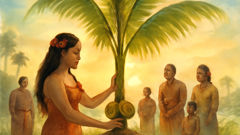
Sina became known across Samoa as the mother of the coconut tree. Wherever she traveled, people welcomed her with songs and gifts made from the tree’s bounty. Children learned to drink the sweet water inside each fruit and to carve bowls and cups from its shell. Families built shelters from its fronds and wove mats for sleeping and feasting. The coconut became the heart of daily life—a source of food, drink, shelter, and joy. And with every use, villagers remembered the story of Sina and her gentle friend from another world.
Yet the legend did not end there. As generations passed, the tale of Sina and the eel was retold in every corner of Samoa. Elders gathered children beneath the spreading palms and pointed to the three marks on each coconut, explaining how they echoed the face of the enchanted eel. Some said that when you drink from a coconut and look through its shell at the world, you see things as the eel once did—filled with wonder and possibility. Others believed that the tree’s whispering leaves carried messages between worlds, reminding all who listened that love could bridge even the widest ocean.
Sina lived a long life, her days shaped by gratitude and remembrance. She became a guardian of the coconut groves, tending each tree with care and teaching her people how to honor the gifts of nature. And as she grew old, she found comfort beneath the palms, knowing that her friendship had changed her land forever. The lagoon where she first met the eel became a place of pilgrimage, its waters shimmering with memories. Lovers came to whisper promises by its shore, and children tossed garlands onto its surface, hoping for a glimpse of a wise, watchful eye beneath the ripples.
The legend of Sina and the eel endures not just in story but in every coconut tree that sways along the beaches of Samoa. It lives in the laughter of children, the songs of elders, and the rustle of leaves in the warm island breeze—a reminder that love’s gifts can shape a world, and that every ending is also a beginning.
Conclusion
To this day in Samoa, every coconut is more than just a fruit; it’s a living echo of Sina’s gentle heart and the enchanted eel’s gift. When islanders drink from a coconut or rest in the shade of a palm, they remember the maiden who turned sorrow into abundance and friendship into a legacy that sustains life itself. The story of Sina and the eel reminds all who hear it that love leaves marks not just on hearts, but on landscapes, turning even farewells into beginnings. Across beaches lined with coconut palms, beneath skies alight with dawn, the legend endures—an eternal bond between land and spirit, between people and nature, waiting to be discovered anew with every telling.

